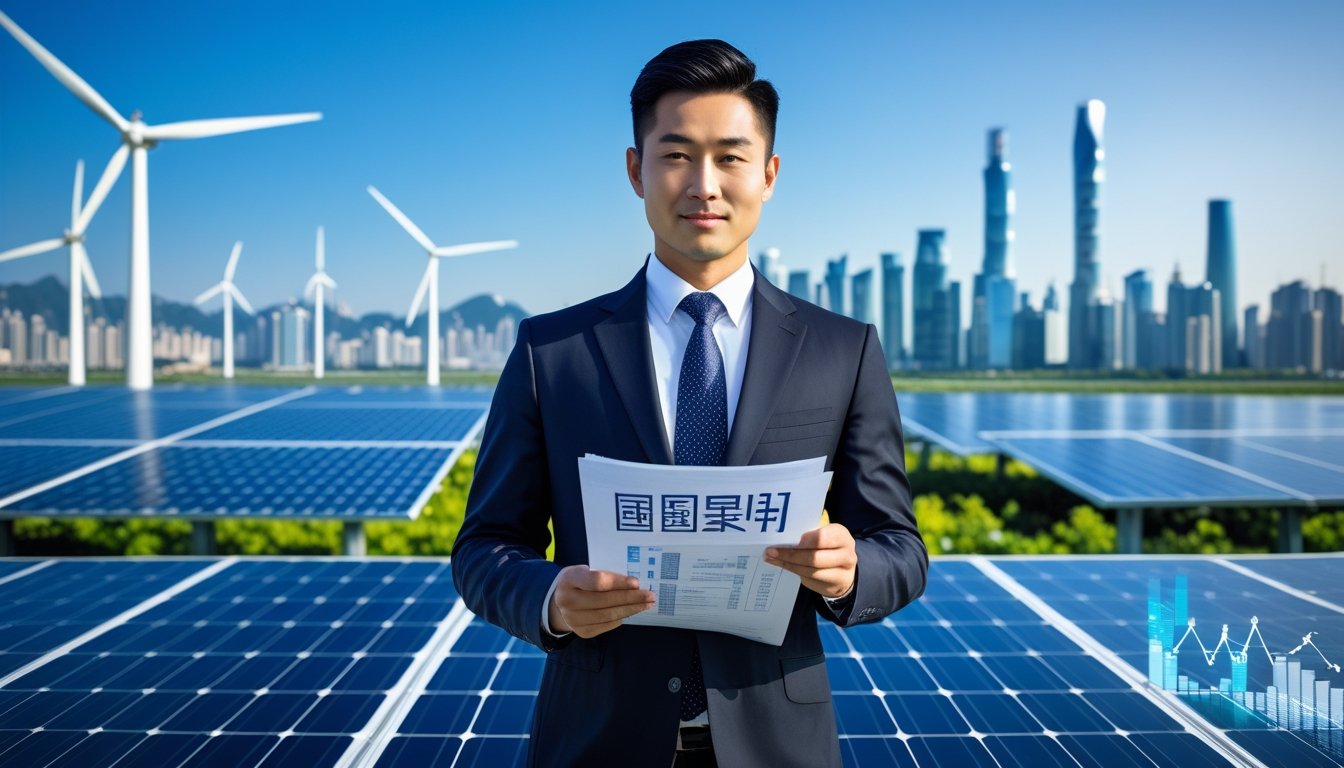China renewable energy has become a global focal point as the country accelerates its transition toward cleaner power. With ambitious national targets, China now leads in solar, wind, and hydropower capacity, reshaping both domestic and international markets.
For businesses and investors, this growth creates significant opportunities—but also complex challenges. Policies shift quickly, competition is fierce, and compliance requirements can be difficult to navigate.
Knowing how China’s renewable energy market works, and the legal framework behind it, is essential for anyone looking to invest or expand in this sector.
Curious about how technology drives change? Explore China’s AI breakthroughs with DeepSeek and their impact on global markets.
What Drives China Renewable Energy Growth

China’s renewable energy boom comes from a mix of state-driven policies, rapid growth in key sectors, and international partnerships. You see it in the government’s clear targets, the way solar and wind industries scale up, and how global players bring in capital and know-how.
Government Policies and National Targets
China’s renewable surge is really about policy. The Renewable Energy Law of 2006 got things rolling, and feed-in tariffs plus subsidies helped kickstart adoption. Lately, the focus has shifted from just building capacity to making sure renewables are actually used.
The 2024 Renewable Energy Substitution Initiative sets out clear consumption goals:
- 1 billion tons of standard coal equivalent (SCE) by 2025
- 5 billion tons of SCE by 2030
These goals push industries to weave renewables into their operations. The government’s also working on grid upgrades, flexible transmission, and energy storage to manage the ups and downs of solar and wind.
Legal changes now allow direct power purchase agreements between renewable producers and consumers, which cuts down on coal use and builds a more competitive power market. Policy isn’t just about adding more capacity anymore—it’s about making the whole system sustainable.
Key Sectors: Solar, Wind, and Hydropower
Solar leads the way. In 2023, China added roughly 200 GW of new solar capacity, more than doubling the previous year’s record. Rooftop solar programs reached more people, while big solar farms in the desert ramped up output.
Wind energy’s also a big deal. Offshore wind projects are expanding, backed by better grid links. Onshore wind is still strong, especially in the north and west, where there’s land and good wind.
Hydropower stays important, but it’s not growing as fast. These days, China’s putting more effort into pumped hydro storage, with 167 GW under construction in 2023. That helps smooth out the bumps from solar and wind. Together, these sectors anchor China’s renewables push and offer steady ground for investors.
Foreign Investment and Technology Partnerships
Foreign partners bring both money and technical skills. International companies often team up with Chinese firms on battery storage, offshore wind, and hydrogen projects. These partnerships boost efficiency and speed up new builds.
China dominates solar panel manufacturing—over 80% of global production stages—which draws in more investment. Lower costs from scale help both China and global buyers.
Through the Belt and Road Initiative, China exports renewable tech and infrastructure, creating cross-border demand. International investors find openings in financing, equipment, and joint ventures. So, China’s renewable sector isn’t working in a vacuum—it’s plugged into the global shift to clean energy.
Market Opportunities and Challenges

China’s renewables market is growing at a rapid clip, driven by strong local demand, export strength, and government incentives. But you’ll need to navigate supply chain snags, shifting regulations, and rising international competition when you look for opportunities.
Expanding Domestic Demand and Export Potential
Renewables now make up more than half of China’s installed power capacity. Solar and wind together topped 1.2 billion kilowatts in 2024, hitting national targets years early. This pace signals strong demand for new projects, grid upgrades, and support tech.
China is a top exporter too, supplying over 80% of photovoltaic modules and about 70% of wind power equipment worldwide. If you’re in manufacturing, project development, or downstream services, there’s plenty of room to grow.
But at home, demand is moving from just adding more capacity to making things run better and smarter. Expect a bigger focus on storage, smart grids, and electrifying industries. These areas are likely to shape where the next big opportunities land as China shifts from expansion to optimization.
Supply Chain Strengths and Weaknesses
China’s manufacturing base is a real advantage. The country leads in producing solar panels, wind turbines, and related gear, which cuts costs and supports exports. Supplier clusters make sourcing parts fast and efficient.
Still, supply chain hiccups are a thing. Grid integration delays can hold up projects, and uneven infrastructure across regions can cause bottlenecks. Some provinces can’t fully use all the renewable electricity they generate, leading to curtailment losses.
There’s also a dependence on imported materials for certain tech, like advanced semiconductors and specialized metals. That opens projects up to global price swings and trade risks. Balancing cost and supply security is becoming a bigger part of project planning.
Risks from Policy Shifts and Global Competition
China’s policy landscape brings both promise and risk. The new Energy Law, arriving in 2025, will unify energy rules and raise the bar for compliance. That means clearer regulations but also tighter oversight of project approvals, land use, and environmental standards.
Policy tweaks can hit profits. For example, moving from guaranteed power purchase to a mixed market-trading system changes how renewable electricity gets priced and sold. You’ll need to adapt to market-based pricing and keep on top of trading rules.
Global competition is heating up. Other countries are pouring money into their own renewables industries to cut reliance on Chinese imports, which could squeeze your export options down the line. Staying ahead may mean focusing on efficiency, tech upgrades, and meeting international standards.
Want to see how green innovation is reshaping industries? Read our insights on the eco-tech revolution in China.
Legal Considerations for Renewable Energy Projects
You’ll need to handle strict regulatory approvals, carefully structured business deals, and smart timing for legal advice when entering China’s renewable market. Each step demands attention to compliance, risk, and alignment with national policies.
Navigating Regulatory Approvals and Compliance
There’s a layered approval process involving both national and local authorities. The National Energy Administration (NEA) and provincial bureaus handle licensing, project registration, and making sure you hit renewable targets.
Projects usually need permits under several laws, including the Renewable Energy Law, the incoming Energy Law, and environmental rules. If your project affects land or water, you might also answer to the Mineral Resources Law or Water Law.
Authorities expect you to meet technical grid standards and pass environmental impact assessments. Missing the mark can mean delays, fines, or even losing project rights.
It helps to keep thorough records, talk to regulators early, and keep an eye on updates to China’s energy plans, like the Five-Year Plans and sector-specific policies.
Structuring Joint Ventures and Contracts
Foreign companies often go the joint venture (JV) route with Chinese partners. JVs help you navigate local rules, secure land, and get financing. But how you set up your JV agreement really matters.
Spell out ownership, profit sharing, and how you’ll handle disputes. Contracts also need to cover IP rights, technology transfer, and performance guarantees.
Pay close attention to power purchase agreements (PPAs) and grid connection deals. These decide how you sell electricity, at what price, and under what terms. A weak PPA can eat into profits.
It’s smart to include exit strategies in case policies shift or your partner runs into trouble. Solid contracts help manage risk and keep things steady in a market that’s still finding its feet.
When to Seek Legal Guidance in China
Get legal advice before you commit to land deals, JV setups, or supply contracts. China’s legal setup for renewables is broad but still evolving, and local practices can differ.
Lawyers who know energy law and cross-border deals can help you decode new rules, especially those tied to the 2025 Energy Law. They’ll also help with compliance—think environmental approvals, foreign investment limits, and tax breaks.
Legal help is crucial for disputes. Arbitration clauses, which law applies, and enforcing foreign judgments all need careful wording.
Bringing in legal pros early lowers your risk of expensive mistakes and makes it easier to roll with regulatory changes that could affect your project’s future.
Planning to invest in renewable energy or tech in China? Learn how our legal services can support your business.
Conclusion: China Renewable Energy
China’s renewable energy sector is not only transforming its domestic economy but also influencing global markets. With strong government support and rapid technological progress, opportunities are abundant—but so are the risks.
From navigating approvals to structuring cross-border partnerships, legal foresight is key to ensuring that investments remain secure and profitable. Companies that prepare strategically will be best positioned to benefit from China’s clean energy transition.
For more insights into China’s innovation-driven industries, read our article on China’s robotics sector.
Frequently Asked Questions
China’s right at the center of global renewable energy growth, with strong government policies driving wind, solar, and more. Yet coal is still the country’s main energy source, so there’s a balancing act between ramping up renewables and sticking with fossil fuels.
Is China leading in renewable energy?
Yes. China leads the world in renewable energy capacity, especially in solar and wind. The country’s invested massively in big projects and keeps expanding both onshore and offshore.
Which country is no. 1 in renewable energy?
China sits at the top in total installed renewable energy capacity. The US and EU countries have big sectors too, but China’s overall scale is bigger.
What is China's biggest source of energy?
Coal is still China’s largest energy source. The government keeps supporting coal for energy security, even as renewables grow. So, coal remains the biggest part of the energy mix heading into 2025.
What percentage of China's energy is renewable in 2025?
By 2025, about a third of China’s electricity comes from renewables like solar, wind, hydro, and a few others. The government’s also put minimum targets in place to keep things moving along toward its carbon reduction goals.
Subscribe to receive updates
Subscribe to receive the latest blog posts to your inbox every week.


.jpg)
